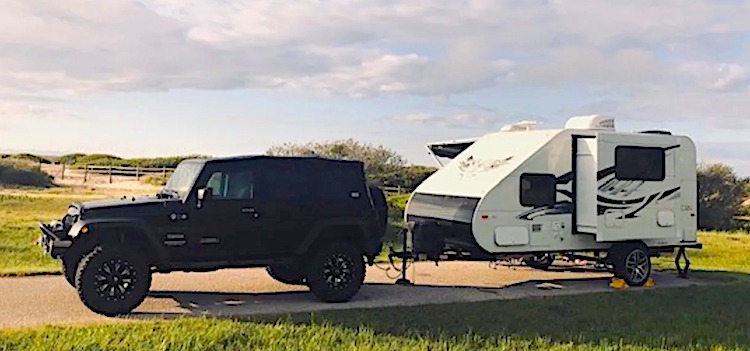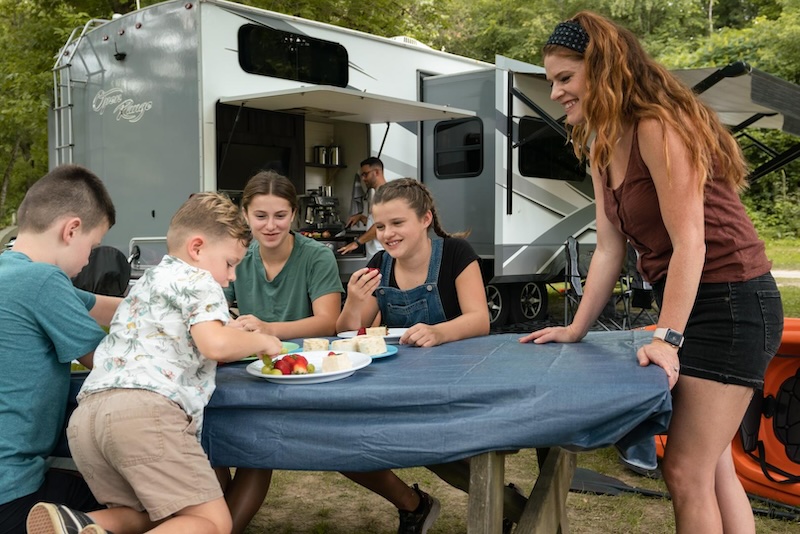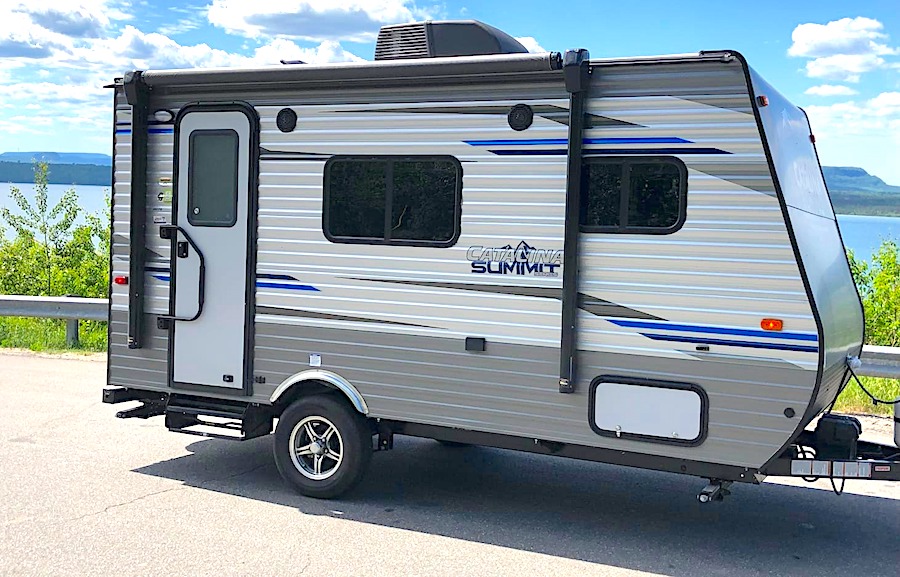Thanks for your support! If you make a purchase using our links in this article, we may make a commission. And, as an Amazon Associate, I earn from qualifying purchases. See the full disclosure here.
Updated April 24, 2024
Is there such a thing as an average travel trailer length? Mathematically speaking, yes, it’s about 30 feet. But you can always average out numbers, so let’s do some checking into why travel trailer length might matter to you.
Susan and I are considering buying a travel trailer and we were discussing how long it should be. We want it to be big enough for us to live in comfortably, yet small enough to tow easily.
We also want to make sure it fits into most campsites. But the number one thing we kept coming back to was the length of the travel trailer.
Of course, we will go through Outdoorsy to find our travel trailer rental. They have a great platform that makes renting an RV easy and hassle-free.
- What Size Travel Trailer Is Best For A Family?
- Is There a Maximum Travel Trailer Length?
- Typical Travel Trailer Lengths
- Travel Trailer Sizes Best Suited for National Parks
- Measuring the Length and Height of Your Travel Trailer
- What’s The Shortest Travel Trailer?
- What’s The Longest Travel Trailer?
- Final Words About Travel Trailer Length
- Related Reading:
- Mike Scarpignato – Bio
What Size Travel Trailer Is Best For A Family?
The best-size travel trailer for a family fits your family’s needs and the capabilities of your vehicle.
With so many sizes and options available, deciding which travel trailer is right for your family can be overwhelming.
Here are a few things to consider when choosing the perfect-sized travel trailer for your next family adventure.
1. Number of Beds
The number of beds in a travel trailer is crucial when traveling with a family. If you have young children, you may need a travel trailer with bunk beds or a convertible dinette that can double as an extra sleeping space. For larger families, look for a travel trailer with multiple bedrooms or a layout that allows for privacy and comfortable sleeping arrangements.
2. Length
The length of the travel trailer is also essential to consider. A more extended trailer will typically offer more living space and storage but may be more challenging to maneuver and require a larger vehicle to tow. A shorter travel trailer may be easier to handle on the road but sacrifice some living space.
3. Weight
It’s crucial to ensure your vehicle can safely tow the weight of the travel trailer you are considering. Check your vehicle’s towing capacity and match it with the trailer’s weight, including any additional weight from your belongings.
4. Amenities
Travel trailers have various amenities to make your trips more comfortable and convenient. Some essential features include a bathroom, kitchen, air conditioning, heating, and storage space. Consider looking for additional luxuries such as a TV, outdoor shower, or awning.
5. Budget
Before starting your search for the perfect travel trailer for your family, it’s essential to determine your budget. Depending on size and features, travel trailers can range in price from a few thousand dollars to over $100,000. Set a budget and stick to it when browsing options.
6. Research Brands and Models
With numerous brands and models available, it’s essential to do thorough research before purchasing. Look for reviews from current owners and ratings from reliable sources. Consider your specific needs and wants in a travel trailer and compare different models to find the best fit.
Is There a Maximum Travel Trailer Length?
The maximum allowable travel trailer length is determined by each state. I took a look at the lengths allowed in states throughout the USA and averaged out the travel trailer length as a whole. The number I came up with was 41 feet – sounds like a large travel trailer, right? Let’s look at a few state-by-state numbers, however, as examples. Please note, “total length” means the length of your travel trailer and vehicle combined.
- Alabama: Total length: 57 feet – Travel trailer: 28 feet, 6 inches
- Colorado: Total length: 75 feet – Travel trailer: 45 feet
- Florida: Total length: 65 feet – Travel trailer: 48 feet
- Iowa: Total length: 65 feet – Travel trailer: 45 feet
- Louisiana: Total length: 65 feet – Travel trailer: 30 feet
- New Mexico: Total length: 65 feet – Travel trailer: 40 feet
- Texas: Total length: 65 feet – Travel trailer: 28 feet, 6 inches
- Wisconsin: Total length: 70 feet – Travel trailer: 48 feet

Since many RVers travel throughout the United States, it leads one to believe that states tend to not be overly strict with the length of RVs. How could they be if you are traveling with your 35-foot travel trailer from Florida into Louisiana or Alabama?
The total length combination seems to be a more reasonable length to adhere to for obvious safety reasons while making one’s way across the USA. However, keep in mind that each state does have specifications regarding tow vehicles and motor home lengths.
Several websites discuss state requirements and laws. One such site you can use as a good resource is RV Trip Wizard which lists the length height and width of travel trailers in every state. We are an affiliate of RV Trip Wizard and love their trip planning software because you can enter the exact dimensions of your RV into the program. RV Trip Wizard will then plan your trip route so you fit everywhere you want to go!
We learned the hard way that Waze or Google Maps will not work to plan the best route when driving an RV. We actually got stuck at a bridge we could not drive under in rush hour traffic in the Northeast! Yikes! Anyway, we highly recommend RV Trip Wizard not only because you can enter the size of your RV but also because it is the BEST trip planning tool we have found. We absolutely think it is awesome and you will too. Just click on any of our RV Trip Wizard links to check it out for yourself.
Typical Travel Trailer Lengths
Listed below is a variety of travel trailers on the market today. You’ll find that, as with any RV, you can choose from tiny to ginormous when it comes to the size that suits your wants or needs. These examples are a fragment of the world of travel trailers.
It’s best first to determine what you feel most comfortable with towing, the weight your tow vehicle will accommodate, and you and/or your family’s needs. You will have more than enough to choose from when shopping.
From the list below, you’ll see there is no such thing as a “typical” travel trailer length. The sampling of travel trailers below range in an overall length from 9 ½ feet to 42 feet. The world of travel trailers is yours for the taking.
- The Osprey by American Teardrop: 9 feet, 5 inches; 518 dry weight
- The Cricket by Taxa Outdoors: 15 feet long, 1,732 dry weight
- Little Guy Max by Little Guy: 21 feet; 3,140 dry weight
- Cougar 22RBS by Keystone: 25 feet, 11 inches; 5,607 dry weight
- Minnie 2301BHS by Winnebago: 29 feet, 10 inches; 6,000 dry weight
- White Hawk 29FLS by Jayco: 34 feet, 6 inches; 6,800 dry weight
- Atlas 3302RL by Dutchman: 37 feet, 4 inches; 8,848 dry weight
- Puma Destination by Palomino: 42 feet, 1 inch; 10,709 dry weight
Travel Trailer Sizes Best Suited for National Parks

Each National Park has its own policy regarding campground(s), amenities, and RV lengths best suited for their sites. Very few, in fact, we only found 3, provide full hookups. Many provide electricity, but no water hookups, and a large number of national parks offer no hookups whatsoever in their campgrounds.
For those wishing to experience the campgrounds without hookups, you may have the option of using a generator during certain hours and/or filling your freshwater tank for personal use.
We found that, as an average, a length of 30 ft. is the maximum to fit into a national park campground. With that said, you’ll find a surprising number of national parks that now offer availability for 40-foot RVs.
One to two parks we looked at even have accommodations for RVs 50 to 60 feet. Some campgrounds only have a few sites available for larger RVs, so it’s best to make your reservations as quickly as you can.
Camping reservations are generally made 6 months in advance of your arrival at www.recreation.gov. To be assured you reserve the appropriate campsite you need, sign up with a login and password ahead of time at the recreation.gov site.
Then double-check what amenities are provided, the allowable trailer length on the particular campsite (s) you are interested in, if the campground is pet-friendly, and how far in advance you can make a reservation. A few national parks allow reservations more than six months in advance. Many parks can book up quickly, depending on location and time of year.
Some national park campgrounds are contracted out to concessionaires to manage. The recreation.gov site will alert you if this is the case and direct you to the appropriate website so that you can make your camping reservation.
As an added note, remember that most state parks also adhere to sites that can accommodate only RVs of particular lengths. State parks tend to offer sites with electricity and water at a minimum and do provide dump stations. Be sure to check each state park’s amenities and allowable lengths before reserving.
RELATED READING: For some great info about camping in National Parks check out our article called 11 Essential Tips for RV Camping in National Parks.
Measuring the Length and Height of Your Travel Trailer
Travel trailers and RVs, in general, can have a few length and height criteria depending on why you need the measurement. The interior length, width, and height is your actual living space. The width, therefore, would be measured with all slides extended to include actual living space.
The exterior length and height are helpful to know for several reasons. Perhaps you need to pay a toll, which requires you to travel through the toll booth. You may have covered bridges along your route or small bridges that cross a river or creek. You’ll also need a total length for fitting into campsites or storing your RV.
The exterior width can be measured with the slide-in, giving you the width for traveling particular roads or bridge crossings, as well as a measurement with the slide-out, which will be beneficial when making campground reservations.
For safety’s sake, measure the height of your RV once it is hooked up to the tow vehicle. Be sure to include any vents, air conditioning units, or even antennas that extend up from the roofline. This assures you complete confidence in making it past any drive-throughs, toll booths, bridges, tunnels, and the like.
The exterior length of your travel trailer will always be longer than the interior. The exterior length will be the overall length, including the tongue and bumper. It’s also a good idea to take a total length measurement of the trailer and vehicle once you are hitched up and ready to roll.
Keep these measurements either in the glove compartment of the tow vehicle or an easily accessible place inside your travel trailer. They can come in handy when you least expect it.
As you see, the answer for what an average length travel trailer is may not be quite as simple as it sounds, but rest assured once you find your “average,” it will be just the right answer for you.
What’s The Shortest Travel Trailer?
The title of the shortest travel trailer goes to the Runaway Camper Pod, which has an exterior length of 6.5 ft.
This ultra-compact fiberglass trailer is a small sleeping pod on wheels. It has an aerodynamic teardrop shape and can sleep 1-2 people on the interior mattress.
There is a small storage space but no bathroom or kitchen facilities.
What’s The Longest Travel Trailer?
The Heartland Torque XLT toy hauler model is the market’s longest-production travel trailer.
This fifth-wheel toy hauler features an immense 14-foot-long garage area in the rear, designed to haul multiple motorcycles, ATVs, or even a smaller vehicle like a utility terrain vehicle (UTV) or golf cart.
Outside the garage, it still provides a reasonably spacious living area with residential amenities like a full bathroom, kitchen, living room slideouts, and sleeping for 4-6 people.
While a total length of 46.5 feet is massive for a towable RV, the trade-off is bringing more enormous power sports “toys” along for camping, off-roading, etc., with no need for a separate trail
Final Words About Travel Trailer Length
We aren’t sure which travel trailer length is right for us, but we do know that the length will be a major factor in determining which we will ultimately choose.
Many factors will determine what size travel trailer is right for you. The size of your family and how you plan on using the RV will be the big ones. Whichever size travel trailer you choose the most important thing is to make the time to use it!
Related Reading:
– 12 Best Travel Trailers with Bunk Beds
– 5 Awesome Class C RVs with Bunk Beds
– 8 Best Class A RVs With Bunk Beds
– 8 Small RV Master Bedrooms with Lots of Space
Mike Scarpignato – Bio
Mike Scarpignato created RVBlogger.com over five years ago in 2018 to share all we have learned about RV camping.
Mike is an avid outdoorsman with decades of experience tent camping and traveling in his 2008 Gulf Stream Conquest Class C RV and 2021 Thor Challenger Class A motorhome.
We attend RV Shows and visit RV dealerships all across the country to tour and review drivable motorhomes and towable trailers to provide the best evaluations of these RVs in our blog articles and YouTube videos.
We are 3/4-time RVers who created RVBlogger.com to provide helpful information about all kinds of RVs and related products, gear, camping memberships, tips, hacks and advice.



